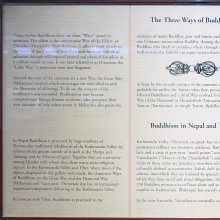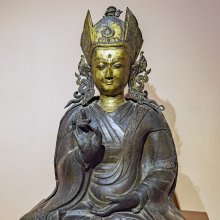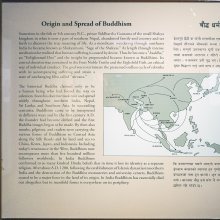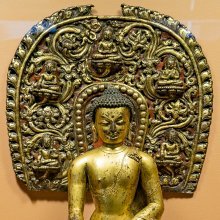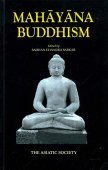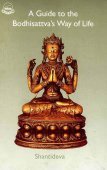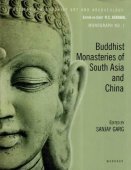Buddhism: 6 definitions
Introduction:
Buddhism means something in Buddhism, Pali, Hinduism, Sanskrit, the history of ancient India. If you want to know the exact meaning, history, etymology or English translation of this term then check out the descriptions on this page. Add your comment or reference to a book if you want to contribute to this summary article.
Images (photo gallery)
(+80 more images available)
In Hinduism
Purana and Itihasa (epic history)
Source: archive.org: Puranic EncyclopediaBuddhism (बुद्धिस्म्).—(BUDDHA-MATA). The origin of Buddhism was in the sixth century B.C. This new religion was shaped out of Hinduism that prevailed at that time. Buddhism which had its origin in North India, prevailed everywhere in India up to the eleventh century A.D. During that period there was an overflow of this religion to the other parts of Asia. Now this religion has its full sway over the people of Burma. 90% of the population there, are adherents of Buddhism. 80% of the people of Thailand, 60% of the people in Ceylon and Japan and 17% in China are now Buddhists. In India, Pakistan and the Philippines the Buddhists are only a minority. Even though Indonesia is a Muslim country there is a small class of Buddhists there. Combodia, Lavos and Tibet are considered to be Buddhist countries. In Nepal there are only two religions, Hinduism and Buddhism. In countries outside Asia there are followers of Buddhism. Statistics reveal that there are one hundred and sixtyfive thousand Buddhists in North America, one hundred and thirtyfive thousand in South America, and ten thousand in Europe. The number of Buddhists in the world today is 150.31 crores.

The Purana (पुराण, purāṇas) refers to Sanskrit literature preserving ancient India’s vast cultural history, including historical legends, religious ceremonies, various arts and sciences. The eighteen mahapuranas total over 400,000 shlokas (metrical couplets) and date to at least several centuries BCE.
Vaishnavism (Vaishava dharma)
Source: Pure Bhakti: Bhagavad-gita (4th edition)Buddhism (बुद्धिस्म्) refers to “philosophy introduced by Śākyasiṃha Buddha that expounds voidist concepts of the Absolute Truth known as śūnyatā or śūnyavāda”. (cf. Glossary page from Śrīmad-Bhagavad-Gītā).

Vaishnava (वैष्णव, vaiṣṇava) or vaishnavism (vaiṣṇavism) represents a tradition of Hinduism worshipping Vishnu as the supreme Lord. Similar to the Shaktism and Shaivism traditions, Vaishnavism also developed as an individual movement, famous for its exposition of the dashavatara (‘ten avatars of Vishnu’).
In Buddhism
General definition (in Buddhism)
Source: WikiPedia: BuddhismBuddhism is a family of beliefs and practices considered by most to be a religion and is based on the teachings attributed to Siddhartha Gautama, commonly known as "The Buddha" (the Awakened One), who was born in what is today Nepal. He lived and taught in the northeastern region of the Indian subcontinent and most likely died around 400 BCE.
Buddhism is broadly recognized as being composed of two major branches:
- Theravada, which has a widespread following in Southeast Asia
- Mahayana (including Pure Land, Zen, Nichiren Buddhism, Shingon, Tibetan Buddhism and Tendai), found throughout East Asia. It should be noted that in some methods of classification, Vajrayana is considered a third branch.
India history and geography
Source: archive.org: Nilamata Purana: a cultural and literary study (history)Buddhism was once commonly seen and practised in ancient Kashmir (Kaśmīra) according to the Nīlamatapurāṇa.—The dwelling places of the Śākyas should be whitewashed and the walls of the Caityas—the abodes of the god—should be decorated with paintings. Gifts of clothes, food and books should be made to the Buddhists and a festival swarming with dancers and actors should be celebrated. Worship of Buddha with eatable offerings, flowers, clothes etc. and the charities to the poor should continue for three days.
Kalhaṇa testifies to the high popularity of Buddhism in Kaśmīra from the time of Aśoka up to that of Lalitāditya. Hiuen Tsang refers to hundred Buddhist monasteries in Kaśmīra, and Ou-Kong gives the number over three hundred. As regards the archaeological evidence, the Buddhist buildings of 8th cent. A.D. only have been discovered as yet in Kaśmīra, but the images of Buddha and Bodhisattvas discovered in the valley can be assigned to an early period.
Source: What is India: Inscriptions of the ŚilāhārasBuddhism during the reign of the Śilāhāra dynasty (r. 765-1215 A.D.).—The only Buddhist inscriptions of the period discovered so far exist at Kānherī, which seems to have been a fairly flourishing centre of that religion in Koṅkaṇ in the reign of the Early Śilāhāras. The inscriptions show that the centre attracted devotees from far-off places like Gauḍa or West Bengal. They made permanent endowments (akṣaya-nīvis) for the worship of the Bhagavat (Buddha) and the food, clothing and books of the monks residing in the caves by depositing the necessary amounts of drammas with the Venerable Community of the place. We have no further mention of this centre of Buddhism until we come to the time of Mallikārjuna (the second half of the 12th cen. A.D.), one of the later Śilāhāras.
Source: Singhi Jain Series: Ratnaprabha-suri’s Kuvalayamala-katha (history)Buddhism refers to one of the topics taught at the Educational institutions in ancient India, which attracted students from near and distant countries, as depicted in the Kathās (narrative poems) such as Uddyotanasūri in his 8th-century Kuvalayamālā (a Prakrit Campū, similar to Kāvya poetry).—Page 150.17 f. & 151.1-5: There is described an educational institution which included students from Lāṭa, Karṇāṭaka, Mālava, Kaṇṇujja, Godāvarī (Nasik), Mahārāṣṭra, Saurāṣṭra, Śrīkaṇṭha (Thanesvar) and Sindha. The courses of study comprised [e.g., Buddhism] [...]. At another place (151.6-11) the prince came across persons who cultivated the seventy-two arts and sixty-four sciences, [...].

The history of India traces the identification of countries, villages, towns and other regions of India, as well as mythology, zoology, royal dynasties, rulers, tribes, local festivities and traditions and regional languages. Ancient India enjoyed religious freedom and encourages the path of Dharma, a concept common to Buddhism, Hinduism, and Jainism.
See also (Relevant definitions)
Starts with: Buddhism And Christianity, Buddhism And Evolution, Buddhism And Science, Buddhism in nepal, Thai Buddhism.
Ends with: Buddhism in nepal, Burmese Buddhism, Chinese Buddhism, Greco Buddhism, Homosexuality And Buddhism, Indian Buddhism, Japanese Buddhism, Korean Buddhism, Northern Buddhism, Southern Buddhism, Thai Buddhism, Tibetan Buddhism, Vietnamese Buddhism, Western Buddhism.
Full-text (+5019): Nagarjuna, Bon, Vijnanavada, Sarvastivada, Dharmapala, Mahayana, Bodhisattva, Theravada, Madhyamaka, Vairocana, Vaibhashika, Atisha, Asanga, Aryadeva, Vajrapani, Matipura, Bauddha, Brahma, Ashoka, Mayavada.
Relevant text
Search found 296 books and stories containing Buddhism; (plurals include: Buddhisms). You can also click to the full overview containing English textual excerpts. Below are direct links for the most relevant articles:
A Correct Vision (by Venerable Professor Dhammavihari)
Socially Engaged Buddhism (with reference to Australian society) (by Phuong Thi Thu Ngo)
Definition and Scope of Socially Engaged Buddhism < [Chapter 1]
Buddhist and Its Developed Period in Australia < [Chapter 3]
Tibet (Myth, Religion and History) (by Tsewang Gyalpo Arya)
7. Vajrayana Buddhism of Tibet < [Chapter 7 - Buddhism in Tibet]
10. Conclusion < [Chapter 7 - Buddhism in Tibet]
4. Buddhist renaissance; bsTanpa Phyi dar < [Chapter 7 - Buddhism in Tibet]
Buddhist Education in Thailand (critical study) (by Smitthai Aphiwatamonkul)
2.1. The Roles on Propagation < [Chapter 3 - The Impact of Buddhist Education on Thai Sangha]
1. Influences of Buddhism < [Chapter 3 - The Impact of Buddhist Education on Thai Sangha]
The Buddhist Path to Enlightenment (study) (by Dr Kala Acharya)
4. Jainism and Buddhism < [Chapter 4 - Comparative Study of Liberation in Jainism and Buddhism]
7. Difference between Mokṣa and Nibbāna < [Chapter 4 - Comparative Study of Liberation in Jainism and Buddhism]
3. Outline of this Research < [Chapter 1 - Introduction]
Stupas in Orissa (Study) (by Meenakshi Chauley)
Tantric Buddhism in Orissa (Introduction) < [Chapter 2]
Probable causes for the decline of Buddhism in Orissa < [Chapter 2]
During the time of Asoka (third century BCE) < [Chapter 2]
Related products
(+11 more products available)

